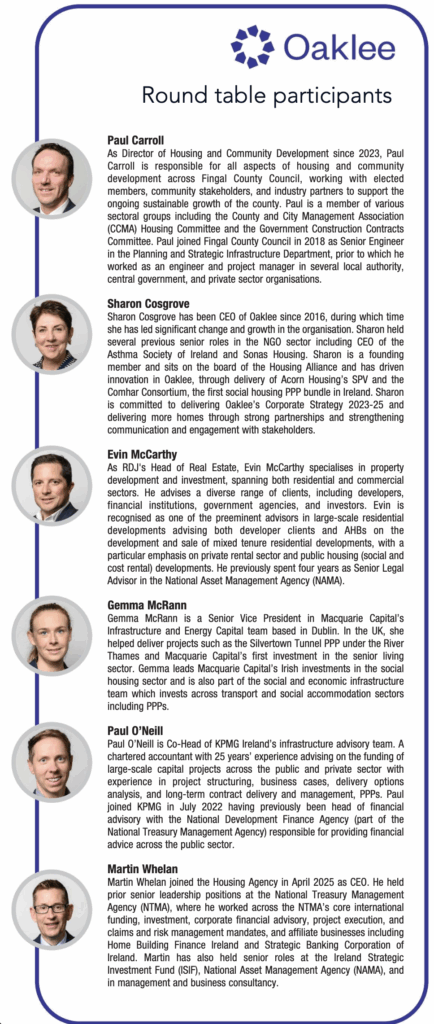
Denmark’s nonprofit housing model
1st July 2025
An Coimisiún Pleanála established
1st July 2025Roundtable discussion: Addressing the challenges of delivering mixed tenure projects

Attended by practitioners from across the housing system, Oaklee hosted a round table discussion to consider how best to address the challenges of delivering mixed tenure projects.
What is the current extent of – and need for – mixed tenure housing in the State?
Sharon Cosgrove
Mixed tenure has been a part of national housing policy since the 1980s. We know from mistakes in the past that there is a need for mixed tenure because it delivers better communities, better social cohesion, more sustainable communities, and better outcomes for people, especially those from low-income backgrounds. The need is well-established; The Housing Commission has recommended that 20 per cent of the State’s housing stock be social and affordable units. While the knowledge already exists, we must now maintain the vision and commitment to create stronger, more integrated communities through mixed tenure developments.
There is a significant need for housing delivery across all tenure types. Fingal County Council is delivering several large, mixed tenure schemes. As a local authority, we are acutely aware of the challenges that come with any one form of tenure dominating housing delivery, and these are challenges which take many years to unwind. We need to ensure that sustainable communities are being constructed and that the necessary investment is being made.
Evin McCarthy
From the commercial developer perspective, mixed tenure is critical for the viability and de-risking of projects. Developments do not commence until the exit is identified, and without the underpinning of large-scale social and affordable cost rental purchasers, we cannot have a diverse and commercially viable delivery model.
Gemma McRann
We need more housing in Ireland across all tenures. From a capital funding perspective, we have seen in the UK that a social, affordable, and shared ownership funding framework can unlock other forms of private development in a market where housing is not being delivered.
Paul O’Neill
I agree that we need more delivery across all tenures, but we run the risk of limiting delivery by being too stringent in the parameters we set. Take cost rental for example. We know the model works but the constraints around achieving minimum reductions against market rents or meeting certain income deciles does make it challenging, and this is reflected in the fact that we have not delivered at the scale we aspire to.
Martin Whelan
There is a significant need for mixed tenure. Mixed tenure is a cornerstone for the creation of sustainable and inclusive communities. There is understandably a focus on the goal of increasing supply, but this should be seen as a means to an end, rather than an end in itself – a critical means to the achievement of more sustainable communities and well-designed mixed tenure is a critical component in this process. Mixed tenure is also a key aspect of delivering larger schemes. This is illustrated by the significant momentum that cost rental has attracted as a new tenure – it is playing a key role in providing homes that people need whilst unlocking housing supply more generally.
What are the most significant barriers to the delivery of mixed tenure projects?
Evin McCarthy
The foremost challenge being experienced at present is the slowdown in public funding approvals. This is impacting on delivery of houses and schemes where the developer has already overcome the significant planning and infrastructure challenges. It has led to developments being mothballed following completion of enabling works, or preventing commencement at all, pushing delivery times out by months against a backdrop of cost inflation. We must address this, or delivery and viability will continue to be challenged.
“Successful mixed tenure projects are greater than housing alone.” Sharon Cosgrove
Sharon Cosgrove
There is interdependence between cost rental and social tenures in Oaklee’s development programme. Some local authorities stipulate that delivery on housing tenure must be on a 50:50 basis for social and cost rental. Others have a 70:30 delivery requirement. Local authorities have demonstrated good leadership in outlining the need, but after the approval process for AHB delivery – both internally and externally – the constraints are that there might be money left in one pot for social, but not in another for cost rental. There is a need for approval and funding processes to align which reflect the fact that it is one mixed tenure project which is being delivered.
Martin Whelan
The complexity of different funding streams and approval processes is a challenge. So too, in the current environment, is the pressure on capital streams to do more. An example of this is the funding pressures around cost rental, reflecting both the success of this initiative and the scale of the challenge that needs to be addressed. A further challenge is trying to achieve mixed tenure developments beyond the outer rings of cities. The vision is there, but the funding to make it happen is a challenge.
Paul O’Neill
Outside of planning and approvals, one of the main challenges is trying to get investors’ buy-in that we have a credible pipeline of investable projects. Investors know Ireland is a good place to do business, but we will not get their attention with one off projects. The vision and process for cost rental is now established, but the capital for delivery needs a credible pipeline to mobilise for.
Gemma McRann
Commercial viability and funding have been key barriers for housebuilders to delivering new housing at scale. From a private capital perspective, there is an appetite to support housing delivery in Ireland. In Ireland, PPPs and other revenue support models – whether leases, rent backstops, or other models – have facilitated private funding in the past to enter the market to increase supply.
“As a local authority, we are acutely aware of the challenges that come with any one form of tenure dominating housing delivery.” Paul Carroll
Paul Carroll
Broadly, housing delivery is being inhibited by infrastructure shortfalls, especially with roads, water, and energy. I have seen this most particularly in north Dublin, but also in other parts of the country. The lack of zoned service land has been a significant barrier. The zoning is now being addressed by legislation, but the servicing of that land will remain a challenge. It is positive that this is being addressed, but it will remain a barrier in the short term as it will increase the lead-in time required for the delivery of projects.
To what extent does the success of mixed tenure communities hinge on design and management?
Martin Whelan
Good design helps to create communities which people want to, and can afford to, live. Communities that will last. Experience shows that design should be tenure blind as much as possible.
Paul O’Neill
A tenure blind approach is key. Enhanced standardisation can drive efficiency also. Similarly, longer-term estate management is particularly important. As with PPPs, this long-term management is a key benefit in that it maintains the housing stock to a defined standard while importantly preserving community cohesion.
Sharon Cosgrove
Design is critical. Successful mixed tenure projects are greater than housing alone. Placemaking is vital to the creation of new and sustainable communities, supported by tenant engagement initiatives. Similarly, management is crucial. There is no point in delivering new housing stock unless it is professionally managed and maintained. In mixed tenure communities, there are often vulnerable people with specific needs, so good estate management and tenancy management are essential in ensuring that supports can be accessed. Oaklee has social housing stock that is dispersed within private developments, and similarly we have apartment blocks of clustered social housing in private developments. Either approach works, but it is critical that supports and services from other agencies are also in place to support vulnerable tenants and help create safe vibrant communities.
Martin Whelan
Good management is critically important. We are fortunate in this regard that larger AHBs, for example, have been able to extend their considerable experience in managing social housing tenancies successfully to mixed-tenure communities. Capacity is a challenge though. As the number of social and affordable homes increases so too does the need for housing professionals in local authorities and AHBs to support good estate management and tenant services. The Housing Agency has been leading out with an industry consortium to development a new social and affordable housing apprenticeship to help address this skills shortage, with the first enrolment of new apprentices due next year
“The State’s support for mixed tenure is unlocking developments that would otherwise not be viable.” Martin Whelan
Evin McCarthy
Tenure blind is a commendable objective, but it can be difficult to implement in practice where a tension emerges between design and management. For example, the potential for segregation of facilities between separate elements of the developments due to cost constraints on AHBs. Within the legal framework, the Multi-Unit Developments Act 2011 is now 14 years old, and was enacted at a time when large-scale AHB homeownership did not exist. The Act does not account for such constructs from a technical perspective and needs to be reviewed to align with the realities of mixed tenure developments.
Paul Carroll
Design is obviously key. As such, there is a responsibility on us to deliver. We can spend years putting plans in place and promising X, Y, and Z, but too often we have lost momentum. This can create challenges if plans for social and community infrastructure are not delivered. Management is a key aspect for Fingal County Council where we now have over 7,000 units with a trajectory of 10,000. From both an asset and tenant management perspective, we must adopt a more structured and professional approach. Work is ongoing across the public sector to establish new systems to do so. Local authorities are having to consolidate their skills and experience to respond to the pressure of delivery.
To what extent does tenure mixing underpin the economic viability of commercial housing development?
Gemma McRann
Whether through current mechanisms or private funding, social and affordable underwrites can potentially unlock wider development and become part of the solution to scale housing delivery. What private capital needs is a route to scale and visibility of inflation-linked cashflows. For example in the UK, recent announcements that social and affordable rents will increase by CPI +1 per cent for 10 years will help to support further partnerships with housing associations and housebuilders – we have seen private funders underwrite the social, affordable, and shared ownership housing to help deliver a few thousand units per year. There is no reason that a similar model cannot be applied to Ireland to unlock wider housing development, alongside existing models such as PPPs, LDA, and AHB delivery.
“Tenure mixing brings public and private finance together from a collaboration perspective, diversifying revenue streams and unlocking market security.” Paul O’Neill
Paul O’Neill
Tenure mixing brings public and private finance together from a collaboration perspective, diversifying revenue streams and unlocking market security. I would argue that greater focus needs to be on the enabling infrastructure to get construction sites up and running in the first instance, bringing in the utilities to achieve joined up thinking. There are plenty of proven funding models available, including PPPs and wider leasing initiatives. The funding will follow if we have well defined, structured projects.
“From the commercial developer perspective, mixed tenure is critical for the viability and de-risking of projects.” Evin McCarthy
Evin McCarthy
There are two elements. Firstly, the diversification of income streams and scale of typical transactions provides significant hedging against risk. Secondly, there are also clear benefits with having an AHB like Oaklee as a cornerstone of a housing development. Some the private developers are very successfully delivering at scale across each of the tenures. For example, the Balmoston mixed tenure housing scheme being delivered at Donabate by Fingal County Council and Glenveagh, is multiannual with an income stream over several years whilst delivering considerable numbers of social and affordable homes. The forward funding model is also greatly beneficial as site value is realised up front which can then be recycled into development costs. However, attracting private capital into such models can be difficult. There is a danger of overengineering solutions. If the challenge is the viability gap and schemes to address it are complicated – and have low levels of take up as a result – is there scope for examining more straightforward initiatives, for example in relation to VAT rates?
Martin Whelan
It can be very advantageous depending on the development. In many instances, the State’s support for mixed tenure is unlocking developments that would otherwise not be viable, or viable to deliver in the short term. We have seen in the past and currently the role of Part V in underpinning viability, and we now see this across a range of other social, affordable and cost rental funding programmes. To give a sense of this through The Housing Agency’s work, through the Cost Rental Equity Loan scheme, some 2,242 cost rental homes have been delivered by AHBs and a further 4,023 homes are in train; the LDA has delivered over 1,000 cost rental homes with a significant pipeline of new delivery under the Secure Tenancy Affordable Rental scheme – a scheme that is being reviewed to extend it to private sector partners; and contracts have been signed in respect of over 1,000 Croí Cónaithe apartments, a scheme that aims at bridging the viability gap for apartments for sale. These homes are being delivered as part of wider mixed tenure communities and illustrate the role of mixed tenure in underpinning feasibility right now in the housing delivery system.
Paul Carroll
Tenure mixing is underpinning the economic viability of housing altogether. From a Fingal County Council perspective, we have challenging targets under Housing for All, and new targets on the way. It enables us to achieve scale, delivering mixed tenure across sites such as Balmoston and Church Fields, meaning that we are not spreading ourselves across several smaller sites. Instead, we can amalgamate delivery, provide the enabling infrastructure, and make investments that might not be justifiable otherwise.
How can the dynamic between local authorities, AHBs, housing developers, policymakers, and other stakeholders be leveraged to accelerate the delivery of mixed tenure housing?
Martin Whelan
One of the most noteworthy features of the last decade of delivery has been the breaking down of barriers and the increase in collaboration. Because of the scale of the challenge we face, there is no alternative to enhanced collaboration. We are collectively trying to address what is the biggest shared challenge that faces Ireland today – the housing challenge – and we can only do that by working across traditional boundaries.
Sharon Cosgrove
Across the sector, teams from different agencies and organisations are collaborating in a positive manner, but there is room for enhancement. Through PPPs, for example, we have a shared endeavour in which all the different stakeholders are playing their part in a collaborative manner rather than viewing each other’s organisations as being in competition. We must continue to make these relationships work and enhance the collaboration taking place currently.
“Social and affordable underwrites can potentially unlock wider development and become part of the solution to scale housing delivery.” Gemma McRann
Gemma McRann
We each have the different component parts of the broad solution for the sector, and we have observed leadership being shown by the AHBs. We have developers and contractors who have a lot of experience in delivering housing in Ireland. We have models which have worked in the past, including private capital collaborating with AHBs, local authorities through PPPs and other models. These models can be adapted to ensure long-term ownership of social and affordable housing by the Government while providing the initial supporting framework to make these schemes viable and scalable.
Paul O’Neill
While it is positive that there is a strong level of collaboration across the sector, we have a lot of different organisations that are responsible for its delivery, so the key to success is ensuring that there is a simple message which underpins the decisions we make. We also must ensure that the local authorities and AHBs are properly resourced to be able to play their part in leading the delivery of these projects.
Paul Carroll
International capital is now firmly a topic of conversation in the sector, and we are in a position where we are informed about the capital streams available for us to enable delivery. Local authorities must lead on vision and outline the needs of the local population. We need the collaboration because the expertise which enables delivery is in the private sector.
Evin McCarthy
The relationships and collaboration are important and must continue, but we cannot underestimate the scale of the challenge. Cooperation sows the seeds of innovation and the level of joined up thinking is a positive development. We have reason to be positive because we know that we can attract international capital. The key is ensuring that we are continuing in our cross-sectoral collaboration which will ensure that we have a message which is attractive to investors.








